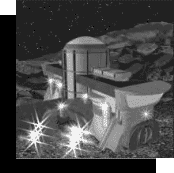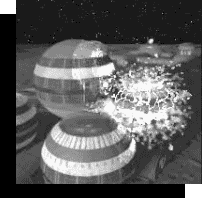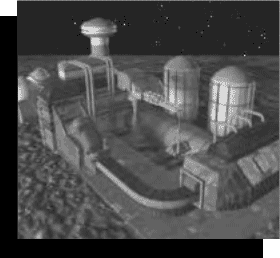**This is an old revision of the document!**
Playing to Survive
Your first goal is quite simple. It is to avoid being killed by plague, famine, lack of oxygen, exposure — you get the idea. In order to survive, you must have the following: mined resources to build and operate your structures; CHAP facilities to provide air to your buildings; Agricultural Domes (AgriDomes) for food; energy; and protected underground residential areas. You must also connect all of these structures with tubes so that air, water, people, and recyclables can pass between them. Later in the game, you’ll play to thrive, but for right now, you’re doing great if you live through the next turn.
Construction
 Build facilities for your colonists at the first opportunity. They’ll really think you’re the greatest if, early on, you provide them with a place to live and food to eat. You should build your first structures in this order: Agricultural Dome, CHAP, Residential Units, Storage Tanks, and Power Facility. Later, as their lower-order needs are met, your colonists will demand Medical Facilities, Research Labs, and Parks. There are a lot of buildings to choose from in Outpost. What does each one do? When it’s time to construct some buildings, use this handy guide showing your building options. For additional information about each facility, use the Help system.
Build facilities for your colonists at the first opportunity. They’ll really think you’re the greatest if, early on, you provide them with a place to live and food to eat. You should build your first structures in this order: Agricultural Dome, CHAP, Residential Units, Storage Tanks, and Power Facility. Later, as their lower-order needs are met, your colonists will demand Medical Facilities, Research Labs, and Parks. There are a lot of buildings to choose from in Outpost. What does each one do? When it’s time to construct some buildings, use this handy guide showing your building options. For additional information about each facility, use the Help system.
Surface Structures
| Title | Description | # People to operate | # Turns to build | Morale effect | Production result | Chance of breakdown |
|---|---|---|---|---|---|---|
| Agricultural Dome | Provides Food | 1 | 5 | +1 | Food | 20 |
| CHAP Facility | Produces life-support gases and water | 4 | 6 | 0 | LSA, LSB, LSC | 10 |
| Command Center | Allows colony-building to commence | 1 | 3 | 0 | 50 | |
| Communications Tower | Extends communications | 1 | 2 | 0 | 5 | |
| DIRT Facility | Helps minimize damage from catastrophes | 2 | 5 | +1 | 0 | |
| Factory | Produces robots, road material, etc. | 1 | 6 | 0 | Robots, Parts, Roads, Fuel Cells | 10 |
| Hot Laboratory | Houses potentially dangerous experiments | 2 | 5 | -1 | Research | 20 |
| Mass Driver | Launches payloads into orbit | 4 | 9 per segment | 0 | 20 | |
| Mine | Provides ore for building | 1 | 7 | 0 | Mined ore | 30 |
| Monorail | Carries ore, resources, or passengers | 1 | 7 per segment | 0 | 30 | |
| Monorail Intersection | Carries ore, resources, or passengers | 1 | 12 per segment | 0 | 30 | |
| Monorail Power | Powers the Monorail | 0 | 6 | 0 | 30 | |
| Monorail Station | Acts as required terminal for Monorail line | 1 | 6 | 0 | 30 | |
| Nanotechnology Facility | Eliminates reliance on resources | 2 | 5 | +1 | No resources requirements | 20 |
| Police | Reduces crime level, improves morale | 2 | 4 surface | +1 or -1 | 20 | |
| Road | Allows transportation of resources | 0 | 2 | 0 | 0 | |
| Robot Command | Communicates with robots, orders repairs | 1 | 3 | 0 | 30 | |
| Seed Factory | Produces robots and processes ore | 0 | 2 | 0 | Robots | 0 |
| Smelter/Ore Processor | Changes ore into processed resources | 3 | 7 | 0 | Processed resources | 10 |
| Solar Powersat Receiver Array | Solar Powersat Receiver Array | 1 | 4 | 0 | Power | 20 |
| Spaceport | Launches cargo and satellites into orbit | 4 | 7 | 0 | 30 | |
| SPEW Facility | Recycles wastes | 2 | 8 | +1 | MPG (Multi-Purpose Goo) | 40 |
| Storage Tanks | Acts as delivery points for processed resources | 0 | 2 | 0 | 0 | |
| Terraforming Facility | Creates breathable atmosphere for planet | 4 | 9 | +5 | Breathable air | 20 |
| Tokamak Fusion Reactor | Creates safe, reliable fusion energy | 1 | 2 if brought, 9 if built | 0 | Power | 5 if brought, 30 if built |
| Trade Mission | Allows trade–built by trade partner | 1 | 2 | 0 | Trade | 0 |
| Tube | Provides a supply line between buildings | 0 | 1 | 0 | 0 | |
| Warehouse | Stores medicine, fuel cells, robots, etc. | 1 | 2 | 0 | 5 |
Underground Structures
| Title | Description | # People to operate | # Turns to build | Morale effect | Production result | Chance of breakdown |
|---|---|---|---|---|---|---|
| Administration | Provides administration site | 1 | 2 | 0 | Increase in productivity | 10 |
| Commercial | Acts as a retail outlet for luxury items | 2 | 3 | +1 | 10 | |
| Geothermal Power Plant | Provides a clean source of energy | 1 | 9 | 0 | Power | 20 |
| Laboratory | Allows “safe” experiments to take place | 2 | 4 | 0 | Research | 20 |
| Light Industry | Produces luxuries, clothing, or medicine | 2 | 4 | 0 | Luxuries, Clothing, Medicine | 20 |
| Medical Facility | Reduces population attrition from disasters | 2 | 4 | 0 | Life extension | 20 |
| Mine Shaft | Provides mine access (built by robominer) | 0 | varies by terrain | 0 | Mined ore | 0 |
| Park/Reservoir | Provides safe environment to play in | 0 | 3 | +1 per turn | Entertainment | 10 |
| Police | Reduces crime level, improves morale | 2 | 3 underground | +1 or -1 | 20 | |
| Recreational Facility | Provides colonists with entertainment | 1 | 4 | +1 per turn | Entertainment | 20 |
| Red Light District | Provides colonists with entertainment | 2 | 4, or spontaneous | +2 per turn | Entertainment | 0 |
| Residential | Houses colonists | 1 | 3 | +1 or -1 | 10 | |
| Tokamak Containment | Contains reactor (built along with reactor) | 0 | varies by terrain | -1 to 0 | 0 | |
| University | Educates the rabble | 2 | 4 | +1 per turn | Education | 20 |
Emergencies
 Crises are a foregone conclusion on your new planet. The variable is your competence in handling such emergencies. Plus, your colonists will be watching to see how you handle yourself, and morale will increase or decrease based on your leadership ability. Such problems are almost nonexistent at the Easy and Beginner levels. A DIRT (Disaster Instant Response Team) Facility will minimize damage from unpredicted events that occur to your structures. The DIRT response area is limited; on average, the DIRT can protect structures within a five-tile radius. The closer a structure is to a DIRT team, the likelier it is to survive catastrophes with minimal damage.
Crises are a foregone conclusion on your new planet. The variable is your competence in handling such emergencies. Plus, your colonists will be watching to see how you handle yourself, and morale will increase or decrease based on your leadership ability. Such problems are almost nonexistent at the Easy and Beginner levels. A DIRT (Disaster Instant Response Team) Facility will minimize damage from unpredicted events that occur to your structures. The DIRT response area is limited; on average, the DIRT can protect structures within a five-tile radius. The closer a structure is to a DIRT team, the likelier it is to survive catastrophes with minimal damage.
Plague
No matter how many times your colonists gargle, they won’t be able to avoid the space-germs that cause plague. When there’s an outbreak you’ll have about 20 turns to respond to the threat. If you’ve had the good sense to establish a Medical Facility, which will double your response window to about 40 turns, or had scientists working on an antidote in one of your Research Facilities, your colony might survive. Keep in mind that Monorails do a very effective job of carrying the plague, so you’d better be ready to cut your losses by bulldozing sections of rail line. If you respond soon enough, you may be able to isolate the plague to just one colony. The chance of a plague striking your colony increases according to your chosen level of difficulty.
Factories
Since you couldn’t bring everything with you from Earth, you had the foresight to bring materials you would need to create factories. In these factories you can manufacture items you require to survive, and later, to thrive.
 There are two major categories of factories: light industry factories, which are clean and non-polluting and which can operate under the planet’s surface; and surface factories, which require much more in terms of raw resources and energy, and which are placed on the surface so that they won't contaminate the environment below.
There are two major categories of factories: light industry factories, which are clean and non-polluting and which can operate under the planet’s surface; and surface factories, which require much more in terms of raw resources and energy, and which are placed on the surface so that they won't contaminate the environment below.
Light Industry Factories provide three commodities:
• Medicine is produced at the rate of one unit per turn. When a medical emergency strikes the colony, stored medicine is automatically used. If there is no medicine in storage, colonists will die. One hundred units of medicine can be stored in a warehouse.
• Clothing is produced at one unit per turn, and is distributed in Commercial structures. Thirty-three units of clothing can be stored in a warehouse.
• Luxury items are produced at the rate of one unit per turn per factory, and are distributed in Commercial structures. Distribution of luxury items is the primary means of manipulating the morale of your colonists, and Commercial structures draw luxuries at a rate of one per turn as long as there are luxury units available. You must choose which luxury items you wish to produce, from a list that includes fuzzy dice and wax lips.
Surface Factories build four basic products:
• Road Material is a combination of dense and sturdy components used to form a durable roadbed on a bulldozed surface. Road Material is produced at the rate of one unit per turn per factory.
• Fuel Cells, used to power robots, are produced at the rate of one every 10 turns. Fuel Cells die after 200 turns of use. Each Fuel Cell takes two mass units of storage, so you can store 50 of them in a warehouse.
• Trucks, used to move resources from the mines to the smelter, are produced at a rate of one every five turns.
• Robots are manufactured in the Seed Factory when you arrive at your new home, but a regular Surface Factory can build the full range of robots, including the new types you’re able to develop through scientific research. A factory can produce only one robot type at a time, which you select, and can build them at the rate of one every five turns. Robot storage at a Surface Factory is limited to 10, after which production stops until the robots are deployed or stored in a warehouse. Warehouses can store 20 robots with fuel cells.
In addition to these Surface Factories, there are five “special” factory types. Each produces one type of product. Note that the Terraforming Facility is only available after suitable research has been performed.
The Agricultural Dome produces food. Each dome produces 10 units of food per turn, assuming the dome receives enough resources per turn, and any research resulting in a new food source increases the amount of food produced. The storage available at a dome is 1000 mass units, after which dome food production is shut down until the stored food is consumed. No other storage for food is available. One unit of food feeds 10 humans per turn.
The smelter processes ores into pure, useful resources. In the smelter, ores produce half their weight in processed metals, and minerals lose nothing. Fusion elements are also processed at a one-to-one ratio. One entire transported load of ore is processed in one turn, after which the processed resources are shipped to colony Storage Tanks to become available for use. Smelter storage is limited, so processing will cease if maximum storage capacity has been reached.
The CHAP (Closed Habitat Atmospheric Production) Facility produces a breathable environment for most of the colony structures. This differs from the Terraforming Facility, which allows an atmosphere to be generated for the entire planet. One CHAP is sufficient to generate the breathable gases for a large colony, but having multiple CHAPs reduces the likelihood of losing your atmosphere production capacity in the event of a catastrophe.
The SPEW (Sewage Processing and Environmental Waste) Facility recycles basic wastes and building materials from structures you’ve chosen to destroy. Recycling improves morale and enables you to reuse resources. Recycled buildings produce MPG (Multi-Purpose Goo), a special synthetic that can be used to replace any other resource required to maintain the functional status of an existing structure.
Terraforming Facilities are generated through extensive scientific research. They allow you to create a breathable atmosphere on certain planets. Success with terraforming has a significant positive effect on the morale of your colonists.
Mining
Gathering Resource Information
Mining and Processing Ore
Mined and Processed Resources
Other Resources
People
Power
Robots
Robot Command
Robot Types
Storage
Transportation
Trucks
Monorails
|
<fs x-small>
Go Back to Outpost Online Manual |